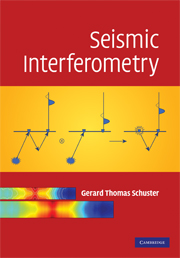Book contents
- Frontmatter
- Contents
- Preface
- 1 Introduction
- 2 Reciprocity equations of convolution and correlation types
- 3 VSP → SWP correlation transform
- 4 VSP → SSP correlation transform
- 5 VSP → SSP convolution transform
- 6 SSP → SSP correlation transform
- 7 VSP → VSP correlation transform
- 8 SSP → VSP → SWP transforms
- 9 Traveltime interferometry
- 10 Stochastic interferometry
- 11 Interferometric source estimation
- 12 Body wave earthquake interferometry
- References
- Index
5 - VSP → SSP convolution transform
Published online by Cambridge University Press: 15 October 2009
- Frontmatter
- Contents
- Preface
- 1 Introduction
- 2 Reciprocity equations of convolution and correlation types
- 3 VSP → SWP correlation transform
- 4 VSP → SSP correlation transform
- 5 VSP → SSP convolution transform
- 6 SSP → SSP correlation transform
- 7 VSP → VSP correlation transform
- 8 SSP → VSP → SWP transforms
- 9 Traveltime interferometry
- 10 Stochastic interferometry
- 11 Interferometric source estimation
- 12 Body wave earthquake interferometry
- References
- Index
Summary
This chapter presents the VSP → SSP convolution transform that converts vertical seismic profile traces into virtual surface seismic profile data. Unlike the cross-correlation reciprocity equations, the convolution reciprocity equation employs the convolution of two causal Green's functions to predict virtual traces. Convolving two short-raypath primaries creates a virtual SSP multiple with a longer raypath, which is opposite to the shortening of raypaths by correlation. Elongating raypaths suggests that the convolution transform can be interpreted as redatuming the acquisition array to be further from the target, a seemingly undesirable operation. However, there are a number of practical uses, one of which is to integrate VSP and SSP data sets collected over the same area.
Introduction
Sometimes SSP and VSP data are both recorded over the same area, with the attendant task of integrating the two data sets. One possible integration strategy is to transform by correlation the SSP traces into virtual VSP data,which can be directly compared to the actual VSP data. The mathematics for this type of redatuming is described in Chapter 8. However, SSP → VSP redatuming can be time consuming because a typical 3D SSP data volume is huge compared to the relatively small VSP data set. Also, interpreters prefer interpreting SSP data because of its wide-area illumination of subsurface geology. An alternative is to redatum the VSP data so that the VSP receivers are virtually relocated to the surface. In this case the raypaths of the VSP reflections become longer after redatuming so traveltimes of events, in the frequency domain, must be added rather than subtracted. As illustrated in Figure 5.1, this means that the Green's function will be temporally convolved rather than correlated as in the previous chapter.
- Type
- Chapter
- Information
- Seismic Interferometry , pp. 109 - 123Publisher: Cambridge University PressPrint publication year: 2009



